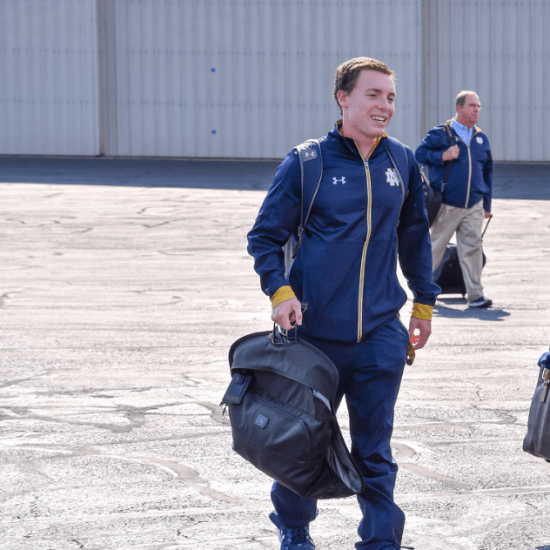As fantasy baseball players dissect last season’s 60-game sprint in preparation for upcoming drafts, many will be confounded by a singular question: How much can you believe performances from 2020?
Was Teoscar Hernandez’s breakout for real? Were Christian Yelich’s struggles a sign of things to come? These types of questions are difficult to assess for the 2020 season due to its uniqueness from any other season in the game’s history. The absence of in-game video, playing in empty stadiums, and disruptions to normal routines are all legitimate explanations for why a player may have struggled. Alternatively, some players’ final stats may appear inflated due to a two-week hot streak. Naturally, the question becomes which stats can we trust given 2020’s limited sample sizes?
Fortunately, significant research already exists that addresses this question. Russell Carleton, Jonah Pemstein, Sean Dolinar, and Derek Carty have all authored informative pieces on sample sizes and stabilization points. For those interested in learning more on when hitter statistics stabilize, their research is available here, here, and here.
The research shows K% is the fastest to stabilize, needing only one fifth of a 162-game season. In general, stats related to plate discipline stabilize the quickest. As a result, they are some of the more reliable descriptive stats in a season with sample size issues abound. Hitters with improved discipline over the 60-game season may have a more believable narrative that they can sustain their success or bounce back.
Understanding whose plate discipline stood out last season should not be used to predict future success. It can, however, be an interesting anchor when searching for undervalued players. Here are a few players who stand out as potential ADP bargains using the 2020 K% and O-Swing% leaderboards.
*NFBC ADP data from 01/01/21 through 02/27/21
Max Muncy, 1B/2B/3B
NFBC ADP: 94.47
O-Swing%: 18.3% (3rd lowest in MLB)
Muncy experienced a down year by most surface-level stats in 2020, most notably a .192 AVG and .720 OPS. As a result, Muncy’s current ADP is hovering around pick 100, a relatively modest decline from last season’s ADP of 67. With his draft stock only falling a few rounds, it appears most early drafters have not been turned off by a player who finished below the Mendoza Line last season. Not only am I willing to look past Muncy’s 2020, but he’s a player I’ll be targeting if I’m not prepared to expend early-round draft capital on DJ LeMahieu or Ozzie Albies.
A large product of Muncy’s 2020 struggles lies in a career-worst .203 BABIP. While Muncy normally crushes fastballs, he hit just .204 on them last season. This was despite an xBA of .284 and whiff rate of just 18.4 on heaters. At the same time, Muncy’s launch angle, barrel rate, and BB/K rate remained consistent with 2019. These metrics suggest last season’s results may have normalized over the course of a full season.
In addition, the Dodgers infielder registered the lowest chase rate of his career, demonstrating his patience at the plate remains intact. Although Muncy hasn’t shown signs of progress with offspeed pitches, there is hope that his elite ability to lay off pitches outside the zone (behind only Cavan Biggio and Mike Trout) will get him ahead in enough counts so that he can get back to hunting fastballs.
Muncy’s mediocre AVG and high strikeout totals certainly have drawbacks. Despite this, he can provide significant ROI at his ADP. His value stems from multi-position eligibility with power production in a loaded Dodgers lineup. The BAT X is particularly fond of Muncy, projecting him for 32 homers, 97 runs, and 92 RBI. Not bad for a seventh or eighth-round pick in a 12-team league! I’ll happily bypass the likes of Biggio, Keston Hiura, or Jeff McNeil who are 2B eligible and drafted before Muncy.
| ADP | Player Name | R | HR | RBI | SB | AVG |
|---|---|---|---|---|---|---|
| 60.75 | Cavan Biggio | 84 | 21 | 68 | 11 | .235 |
| 68.40 | Keston Hiura | 86 | 32 | 92 | 10 | .256 |
| 88.49 | Jeff McNeil | 83 | 17 | 76 | 7 | .277 |
| 94.47 | Max Muncy | 91 | 32 | 86 | 3 | .245 |
Mark Canha, OF
NFBC ADP: 262.85
O-Swing%: 21.6% (13th lowest in MLB)
Mark Canha entered last season with some buzz as a potential breakout after an impressive 2019 where he tallied 26 homers with 80 runs scored. Unfortunately, the 2020 season turned out to be a bit of a letdown as the outfielder experienced a power outage bringing him back to pre-2019 production. With an ADP after pick 250, early drafters appear lukewarm on Canha, likely the product of seeing only five homers over 59 regular season games last season.
Canha provides a high floor that is being underrated at his current ADP. In leagues that start four or more outfielders, he can be a late-round steal to round out your roster. The A’s corner outfielder can return value in just about any format but is especially an asset in OBP leagues. He’s posted elite walk rates in each of the last two seasons due to his unwillingness to offer at pitches outside the zone.
Improved plate discipline and everyday playing time appear to be the two catalysts behind Canha’s 2019 surge as his batted ball metrics have remained consistent throughout his career. Understanding that both variables remained present in 2020 (in fact, his chase rate and BB/K ratio actually improved) has me willing to look past last season in the hopes of late-round counting stats. Since Canha appears locked in at the top half of the A’s lineup with everyday ABs, over 20 homers and ~140 R+RBI seems like a safe bet.
Kyle Seager, 3B
NFBC ADP: 265.99
K%: 13.3% (11th lowest in MLB)
Kyle Seager no longer exhibits the upside he had earlier in his career. As a result, he is overlooked and has the reputation of a boring accumulator. At an ADP outside of the top 250, however, Seager’s high floor and everyday presence in the middle of Seattle’s lineup makes it a near certainty he’ll outperform his draft-day price.
Let’s get the bad news out of the way first: Seager will not be an asset in AVG due to his consistently high fly ball rate. I am generally willing to look past this because any hitter available well past pick 200 will not be without warts. Moreover, there are signs of optimism as Seager displayed the best plate discipline of his career in 2020. In the shortened season, he turned in career bests in K%, BB%, and O-Swing%. Also, there are promising signs within the batted ball data. Seager finished the campaign with a 10.2% barrel rate, putting him in the 66th percentile of qualified hitters. Put simply, hitters with a disciplined approach and multiple seasons of solid batted ball data can be a rare find this late in drafts.
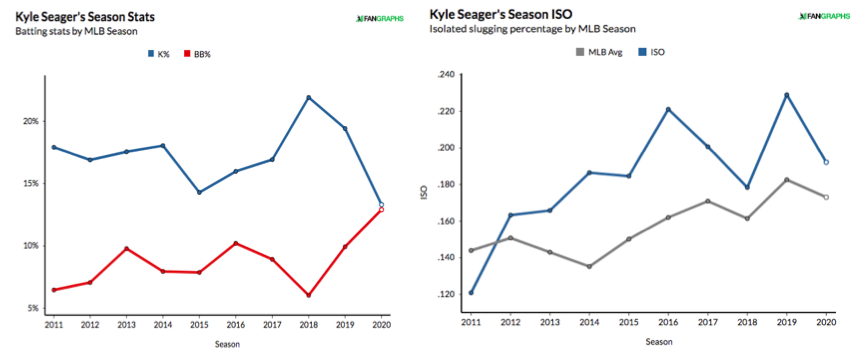
For those finding themselves short of counting stats in the final rounds of a 12-team draft, Seager can be serviceable as a corner infielder or bench option. While it won’t be the most exciting pick you make on draft day, Seager will return value. Put simply, he’ll remain a constant in the M’s lineup and is a safe bet to contribute across three categories. The Bat X projects Seager for 75 R, 28 HR, and 83 RBI in 2021 with a .246 AVG. If you can stomach the low batting average risk, the potential for 25+ homers at the end of your draft sounds like a bargain.
Aaron Hicks, OF
NFBC ADP: 279.04
O-Swing%: 19.9% (6th lowest in MLB)
Aaron Hicks has always displayed an elite eye at the plate, finding himself on plate discipline leaderboards year after year. In 2020, his ability to work a walk was uncanny. His BB% put him behind just two players, absolute stalwarts by the names of Juan Soto and Bryce Harper. Unfortunately, unless you play in an OBP league, Hicks wasn’t a contributor for fantasy squads. Moreover, you likely won’t be impressed by Aaron Hicks‘ surface-level stats or batted ball metrics from the 2020 campaign. Why, then, does Hicks find himself on this list? The answer lies in a familiar narrative and taking a small leap of faith.
As you might remember, Hicks underwent Tommy John surgery at the conclusion of the 2019 season. He didn’t miss a game of action, however, due to the delayed start to the season. The Yankees’ centerfielder was also more passive at the plate than ever before, even appearing tentative to take big hacks. Hicks mentioned as much this spring training saying, “I think extending my right arm (batting) left-handed definitely was making me a little nervous to make full swings. Swinging and missing was definitely a thing I was worried about early on. So I definitely protected it.”
The timidity at the plate was likely a big contributor behind just six homers and a .414 SLG over 54 games. Fortunately, there are recent examples that suggest hitters can take time to regain their power production post-TJS. Both Corey Seager and Didi Gregorius struggled to return to form at the plate in their initial months back on the field in 2019. While all three players profile differently, their rolling xSLG all suggest it takes time to regain pop.
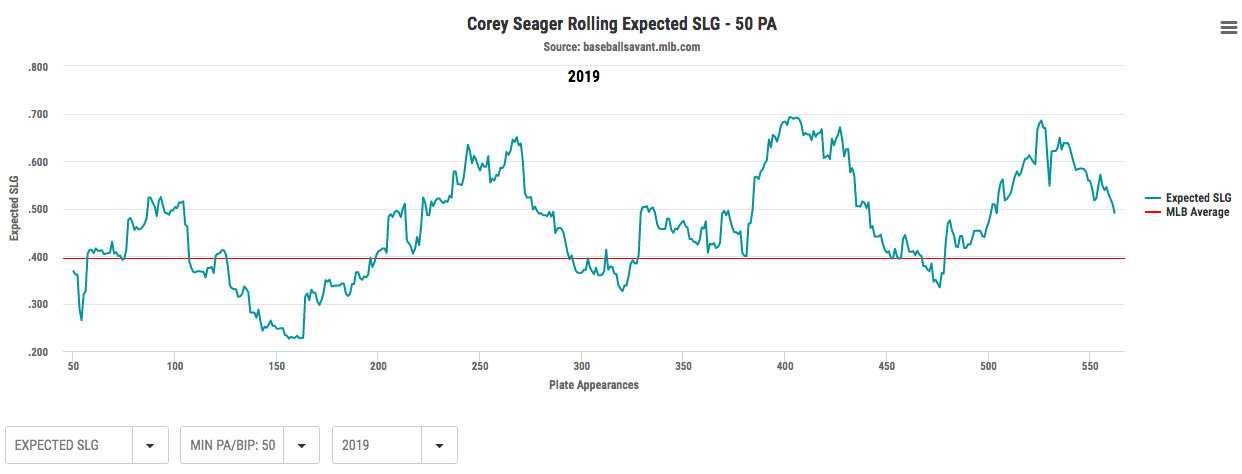
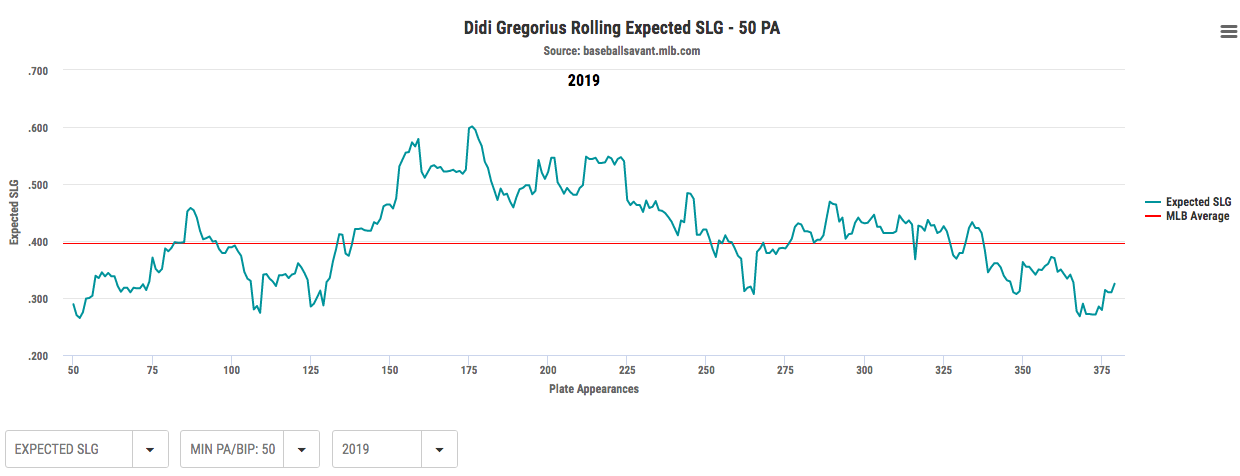
You’ll notice something similar: Neither Seager nor Gregorius was able to sustain much power in the earliest parts of the season. Hicks, however, did not have the luxury of 375+ PAs as the above shortstops.
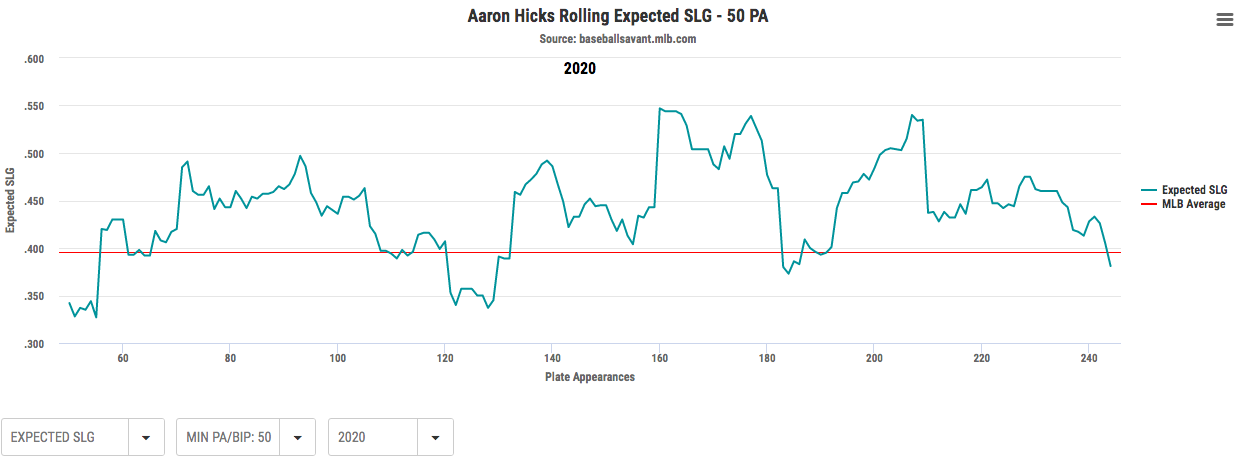
Hicks’ rolling xSLG shows signs for optimism: While his power numbers were disappointing, he did not experience as severe an impact as Seager or Gregorius in his first 200 PA back from injury. With an entire offseason to recover, it’s possible Hicks could put together something closer to his 2018 peak of 27 dingers. The switch-hitter seems to think just that, recently telling reporters, “I definitely see myself hitting 30 plus. That’s what I want to do and that’s what I believe that I can do. If I get 500 plate appearances, I’m definitely going to hit my mark with those numbers.”
While I’m not ready to sign Hicks up for 30 homers, count me in for a bounceback. Not only will he be an additional seven months post-surgery, he has an everyday role in the heart of the Yankees lineup. It’s exceedingly rare to find a player with a guaranteed role at the center of perhaps the game’s most potent lineup at a cost that’s essentially free.
Hicks has earned a reputation as injury-prone, but he managed to avoid the Yankees’ rampant injury bug during the shortened season. While it’s certainly a big assumption he’ll stay healthy, I’ll be more than willing to take that risk on draft day. For those willing to take the risk, cross your fingers for health and enjoy the counting stats.
Honorable Mention: Clint Frazier, OF
NFBC ADP: 182.23
O-Swing%: 17.8% (not enough PAs to qualify)
We all know Red Thunder for his epic bat speed, not his plate discipline. This is for good reason. Clint Frazier has a career strikeout rate of over 28%. His inclusion as an honorable mention stems from a maturing eye for the zone. In parts of three big league seasons prior to 2020, Frazier chased between 23-27% of balls. In 2020, it went down to 17.8%, which would have been good for second-lowest in the league if qualified.
The two words that make me optimistic about Frazier’s 2021 are maturity and opportunity. The improved chase rate (and a 15.6% walk rate), albeit over a small sample, shows a maturing mental approach at the plate that can match his physical abilities. Furthermore, Frazier erased any doubts he could be a major league quality outfielder last season. After some notable blunders in the field in 2019, he posted an 82nd percentile Outs Above Average last season. While you won’t earn fantasy points for his glovework, we now can be confident that a) Frazier’s defense won’t keep him out of the lineup and b) He has the work ethic and maturity to adapt to struggles. Despite an early career filled with ups-and-downs, Frazier proved he belonged when he was given his chance in 2020.
In addition, Frazier will go into 2021 with something new: an assured spot on the roster and in the lineup. Despite the return of Brett Gardner, Aaron Boone has made clear that Frazier would be the starting left fielder. A full season of Frazier where he doesn’t need to look over his shoulder for threats to his playing time could be a boon for fantasy owners.
The starting role appears mostly baked into Frazier’s current ADP around 180. He finds himself around fellow outfield-eligible players in Trey Mancini, Max Kepler, and Kyle Schwarber. I’m extremely bullish on Frazier’s full season potential and see him as an ideal “post-hype sleeper.” While it is not a knock on their potential, I’ll likely be bypassing the likes of Ryan Mountcastle, Dylan Carlson, and Anthony Santander who are currently going in the 150s. Instead, I’ll shore up my infield and pitching knowing there’s a similarly talented young outfielder in Frazier going 30 picks later.
Photos by Ric Tapia, Cliff Welch /Icon Sportswire, NickB149 | Design by Quincey Dong (@threerundong on Twitter)

